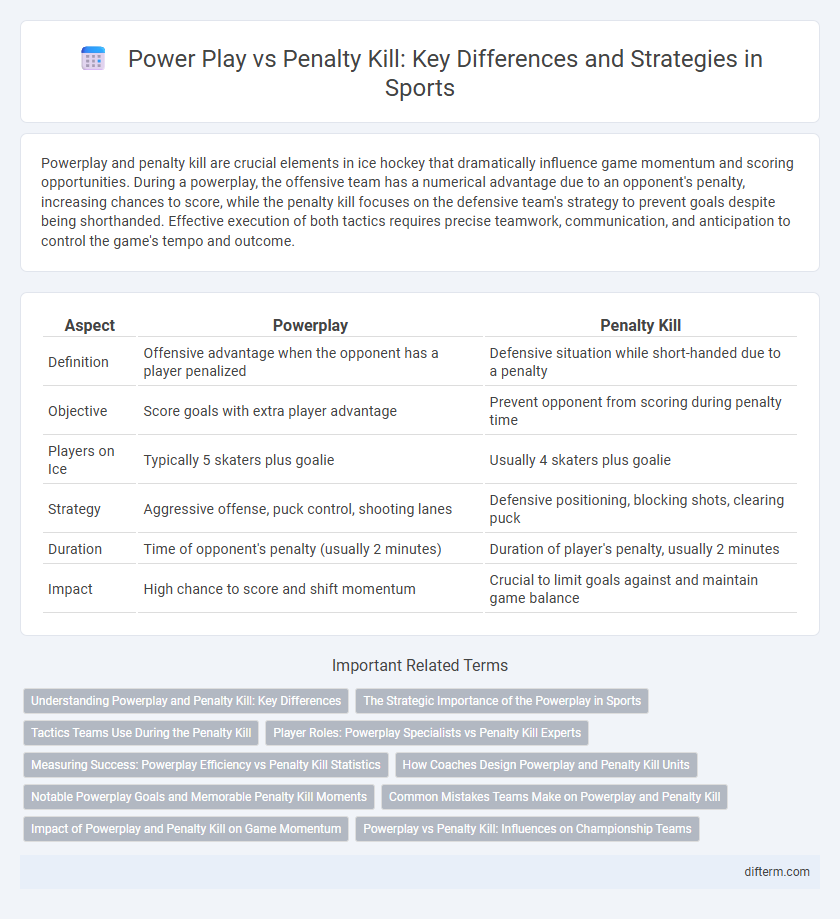Powerplay and penalty kill are crucial elements in ice hockey that dramatically influence game momentum and scoring opportunities. During a powerplay, the offensive team has a numerical advantage due to an opponent's penalty, increasing chances to score, while the penalty kill focuses on the defensive team's strategy to prevent goals despite being shorthanded. Effective execution of both tactics requires precise teamwork, communication, and anticipation to control the game's tempo and outcome.
Table of Comparison
| Aspect | Powerplay | Penalty Kill |
|---|---|---|
| Definition | Offensive advantage when the opponent has a player penalized | Defensive situation while short-handed due to a penalty |
| Objective | Score goals with extra player advantage | Prevent opponent from scoring during penalty time |
| Players on Ice | Typically 5 skaters plus goalie | Usually 4 skaters plus goalie |
| Strategy | Aggressive offense, puck control, shooting lanes | Defensive positioning, blocking shots, clearing puck |
| Duration | Time of opponent's penalty (usually 2 minutes) | Duration of player's penalty, usually 2 minutes |
| Impact | High chance to score and shift momentum | Crucial to limit goals against and maintain game balance |
Understanding Powerplay and Penalty Kill: Key Differences
Powerplay and penalty kill are critical phases in ice hockey, where one team gains a numerical advantage due to the opposing team's penalty. A powerplay occurs when a team has more players on the ice, increasing scoring opportunities by creating open lanes and space for strategic plays. The penalty kill focuses on defensive tactics to neutralize the powerplay, emphasizing aggressive shot blocking, maintaining tight formations, and clearing the puck from the defensive zone.
The Strategic Importance of the Powerplay in Sports
The powerplay in sports like hockey significantly increases a team's scoring opportunities by capitalizing on the opponent's numerical disadvantage during a penalty kill. Teams strategically design powerplay formations and plays to optimize puck control, increase shot quality, and exploit defensive weaknesses. Effective powerplay execution often shifts game momentum, making it a critical factor in securing victories and influencing overall team success.
Tactics Teams Use During the Penalty Kill
Teams employ aggressive zone defense and tight man-to-man coverage during the penalty kill to disrupt the opposition's powerplay formation. They prioritize clearing the puck from the defensive zone quickly while maintaining tight gaps to limit passing lanes and shooting opportunities. Effective communication and positioning allow penalty killers to anticipate plays and force turnovers, reducing the opponent's scoring chances.
Player Roles: Powerplay Specialists vs Penalty Kill Experts
Powerplay specialists excel at creating scoring opportunities by capitalizing on numerical advantages, often positioned as skilled shooters or playmakers who control puck movement and set up high-danger chances. Penalty kill experts focus on defensive discipline, using strategic positioning, shot blocking, and disrupting passing lanes to minimize opponent scoring during short-handed situations. Both roles require unique skill sets that demand situational awareness, stamina, and the ability to read opposing players effectively.
Measuring Success: Powerplay Efficiency vs Penalty Kill Statistics
Powerplay efficiency measures the percentage of successful goals scored during man-advantage situations, reflecting a team's offensive capability. Penalty kill statistics indicate the effectiveness of a team in preventing goals while shorthanded, often represented by the kill percentage or goals allowed per penalty kill. Comparing these metrics provides a comprehensive evaluation of special teams' impact on overall game success in hockey and other similar sports.
How Coaches Design Powerplay and Penalty Kill Units
Coaches design powerplay units by strategically positioning offensive players to maximize puck movement and create high-quality scoring chances, often emphasizing player speed, vision, and shot accuracy. Penalty kill units are structured to disrupt opponent powerplays through tight defensive formations, aggressive puck pressure, and effective shot blocking, prioritizing stamina and positioning discipline. Successful coaches analyze player strengths and opponent tendencies to tailor roles within both units, optimizing transition efficiency and situational awareness.
Notable Powerplay Goals and Memorable Penalty Kill Moments
Notable powerplay goals in hockey often shift game momentum, with players like Alexander Ovechkin and Steven Stamkos renowned for their precise shot accuracy and strategic positioning. Memorable penalty kill moments highlight defensive resilience, exemplified by shutdown specialists like Ryan McDonagh and penalty-killing units achieving critical short-handed goals or flawless clears during high-stakes playoff games. These key special teams plays frequently determine series outcomes and showcase the tactical depth of NHL coaches and athletes.
Common Mistakes Teams Make on Powerplay and Penalty Kill
Common mistakes teams make on the powerplay include poor puck movement, leading to predictable setups and missed scoring opportunities, while failure to maintain puck possession often results in quick turnovers. On the penalty kill, teams frequently commit positioning errors that create dangerous shooting lanes for opponents and struggle with effective clearing of the puck from the defensive zone. Inefficiencies in communication and anticipation during both special teams' situations contribute significantly to defensive breakdowns and goal concessions.
Impact of Powerplay and Penalty Kill on Game Momentum
Powerplay and Penalty Kill significantly influence hockey game momentum by shifting team energy and scoreboard dynamics. A successful powerplay boosts offensive pressure and morale, often leading to critical goals that energize the team and crowd. Conversely, a strong penalty kill disrupts opponents' rhythm, enhances defensive confidence, and can create momentum swings through key clearance or shorthanded scoring opportunities.
Powerplay vs Penalty Kill: Influences on Championship Teams
Powerplay efficiency significantly influences championship teams by maximizing scoring opportunities during opponent penalties, often shifting game momentum. Conversely, a resilient penalty kill minimizes opponent powerplay success, preserving leads and frustrating high-scoring teams. Championship teams strategically excel in both, balancing aggressive powerplay execution with disciplined penalty killing to dominate crucial game moments.
Powerplay vs Penalty Kill Infographic

 difterm.com
difterm.com